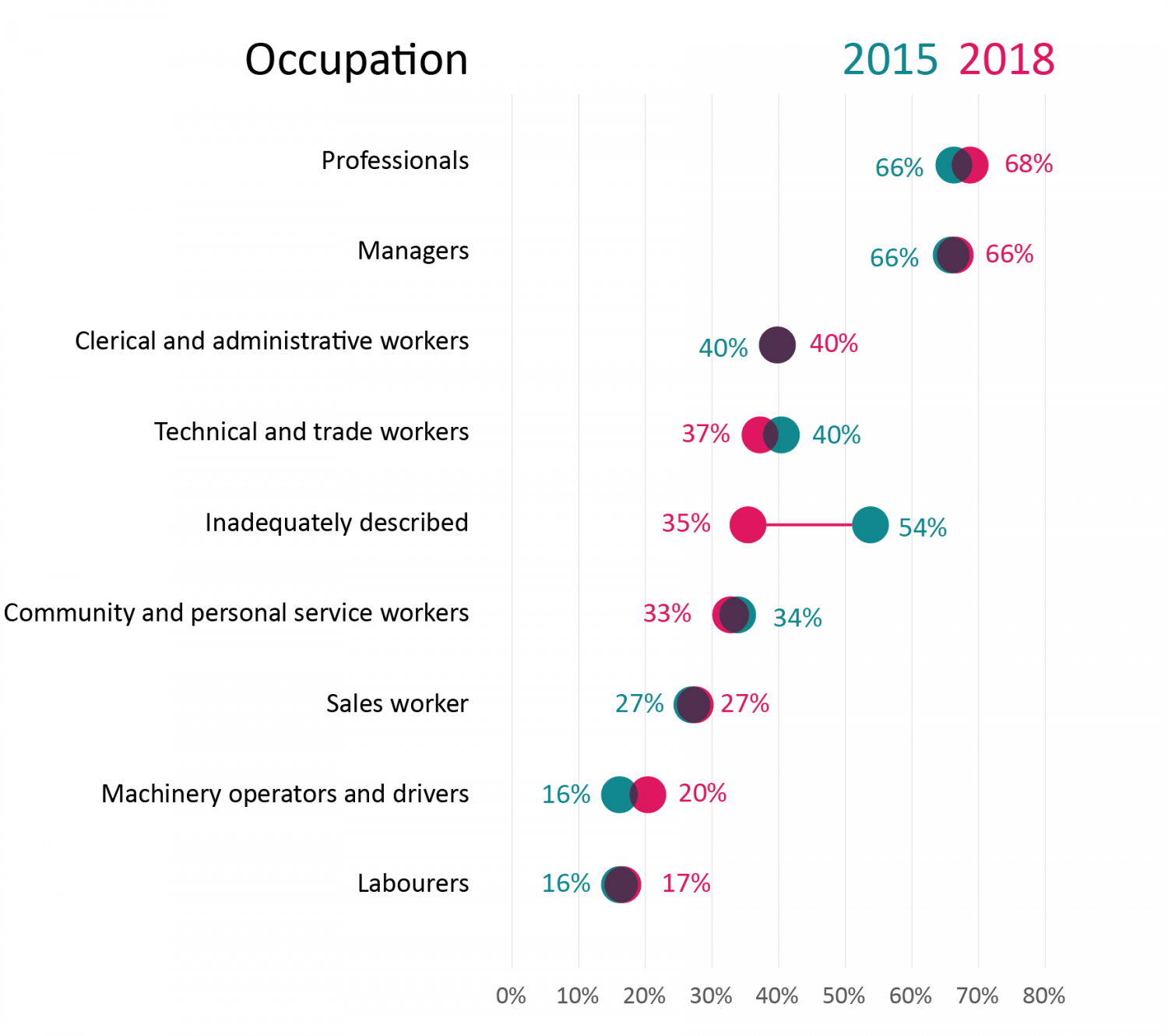COVID-19 has accelerated the transition to remote work globally.
New data by SGS Economics and Planning shows the locations where Australian residents were regularly working from home before the pandemic.
 These are the locations where remote work may continue to scale in the future.
These are the locations where remote work may continue to scale in the future.
This analysis is a step towards understanding how working remotely could reshape the form and structure of Australia’s cities and regions.
It explores the long term benefits and costs of remote working, and the spatial impacts of COVID-19.
It’s clear that the future of work is changing, and the opportunities will vary across the diverse places and communities in our cities.
We need to continue to bring a spatial lens to urban policy and continue to address social and spatial inequalities.
The shift in remote work
Telecommuting, or working from home, gained attention in the 1990s and was seen as the future of work.
It was enabled through advances in communications and digital technologies and heralded as the answer to the traffic woes of our big cities.
In NSW, Action for Transport 2010 included initiatives from the State Government to encourage teleworking from regional cities rather than residents doing long car based commutes. Many organisations embedded flexible work into their policies, with hopes of reducing operating costs.
googletag.cmd.push(function() { googletag.display(‘div-gpt-ad-1591951428937-0’); });
However, a widespread culture of remote work was slow to take off, partly explained by management cultures that preference ‘line of sight’, and the appeal of face to face client, and business to business engagement.
Thirty years on, working from home has happened quickly and at scale.
Governments responded to the COVID-19 health pandemic by putting in place health orders requiring an employer to allow employees to work at home (where practical to do so).
This time, the shift was driven by the need for physical distancing to stop the spread of a highly infectious disease, not by a desire to reduce commuting times or operating costs.
This was more difficult for some, however, as many occupations were simply unable to operate remotely.
Benefits and costs are yet to be revealed
For occupations that can be performed remotely, the long term benefits and costs are yet to be revealed.
For workers, foregoing a daily commute has presented opportunities to better balance family responsibilities, improve lifestyles, and offer a greater choice of housing location and affordability.
 A survey in July 2020 by the National Growth Areas Alliance (NGAA) showed commuting by car to work from outer growth suburbs costs commuter $5.4 billion a year, equivalent to $8,380 each year for a full-time worker.
A survey in July 2020 by the National Growth Areas Alliance (NGAA) showed commuting by car to work from outer growth suburbs costs commuter $5.4 billion a year, equivalent to $8,380 each year for a full-time worker.
Research by SGS for the City of Whittlesea shows women living in growth areas are more likely than men to be tertiary educated, but almost twice as many men are working full time compared with women.
It is anticipated that greater flexibility and allowing people to work from home could increase women’s workforce participation, particularly in outer suburbs.
For businesses, a move to remote working has reduced the need for floorspace and therefore rent, and increased access to a larger potential workforce.
For cities, there is the potential to reduce peak transport congestion, reduce traffic emissions, and revitalise local centres.
There are also downsides associated with risks of isolation, a lack of team engagement and loss of economic activity in city centres.
 The long term impacts on productivity also remain unclear – reducing face to face interactions and knowledge sharing could, over the long term, result in reduced productivity which may more than offset the gains related to reduced travel.
The long term impacts on productivity also remain unclear – reducing face to face interactions and knowledge sharing could, over the long term, result in reduced productivity which may more than offset the gains related to reduced travel.
If remote working continues at an increased rate, there is no doubt that it has the potential to fundamentally reshape the form and structure of our cities.
This article shares new data on the locations where residents are more likely to see ongoing shifts to remote working.
SGS has mapped the home locations of people employed in occupations that are most able to work from home, which varies significantly across our capital cities.
This data provides a starting point to understand the locations that are most likely to see an increase in remote working.
It provides the basis for understanding the potential opportunities to shift the spatial structure of cities.
How widespread will remote working be into the future?
COVID-19 has shown that remote working can be done at scale.
However, the pandemic has also highlighted those industries and workforces that were not able to work from home.
 In the UK, nearly half of people in employment were estimated to be working from home in April when the pandemic response was first put in place.
In the UK, nearly half of people in employment were estimated to be working from home in April when the pandemic response was first put in place.
This marks a significant shift given that prior to the pandemic, less than 30 per cent of people had ever worked from home.
The ABS Household Impacts of COVID-19 Survey found nearly half (46 per cent) of all Australians who were working in late-April to early-May said they were working from home, with women more likely to have been working from home than men (56 per cent compared with 38 per cent).
The national Australian Census in 2016 identified that in Greater Sydney, only 4.7 per cent of workers worked from home on census day.
ABS data shows that professionals (68%) have the highest proportion of people who accessed the internet for home based work on a regular basis for their employer.
Machinery operators and drivers (20%) and labourers (17%) had the lowest proportions of home based workers who accessed the internet for home based work.
FIGURE: WORK FROM HOME BY OCCUPATION 2015 TO 2018

SOURCE: SGS 2020, ABS 2018, HOUSEHOLD USE OF INFORMATION TECHNOLOGY, 2016-17 (2018 RELEASE) AND 2014-2015 (2016 RELEASE)
The rates of working from home during the pandemic varied significantly by industry and occupation.
Of course, frontline health care workers, social assistance workers and retail workers, as well as those in the transport, logistics, manufacturing and construction sectors are not able to work from home.
Their work is location specific, or requires particular tools and equipment that cannot be accessed from home.
These are the people that have been most vulnerable to COVID-19.
 The spatial impacts of COVID-19 went beyond occupations.
The spatial impacts of COVID-19 went beyond occupations.
SGS analysis on the casualisation of the workforce showed that COVID-19 did not affect all Melbournians equally.
The greater propensity for personal contact renders some workers at greater COVID-19 risk.
This was borne out by the pattern of confirmed cases of COVID-19 in Melbourne as accumulated since the start of the pandemic.
It is still up for debate whether or not the experience of the COVID-19 response will fast-track more widespread remote working.
Six months on from the initial COVID-19 response, the health orders for remote working still vary nationally.
In SA and the ACT, changes in late September and early October respectively have meant workplaces may commence a return to the workplace if it suits employers and employees and if COVID-Safe Management Plans are in place.
In Queensland, the ability to return to offices has been in place since mid-June.
In early November 2020, NSW and Victoria public health orders remain in place requiring employers to give employees the option of working from home, where reasonably practical to do so.
The longer these health orders are in place, the more established patterns of behaviours are likely to become.
 In the USA, a survey of workers who are able to work from home suggests their ideal ongoing arrangement would be to continue working from home 1 to 4 days a week, with 40 per cent working from home daily, with just 14 per cent wanting to return to a workplace daily.
In the USA, a survey of workers who are able to work from home suggests their ideal ongoing arrangement would be to continue working from home 1 to 4 days a week, with 40 per cent working from home daily, with just 14 per cent wanting to return to a workplace daily.
Similar research from the University of Sydney Business School suggests that more Australian’s want to work from home an average of two days a week post pandemic.
The September ABS Business Impacts of COVID-19 survey found 43 per cent of businesses currently have staff teleworking, compared to 23 per cent prior to COVID-19, and 29 per cent of business expect staff to continue to telework once restrictions are lifted and conditions stabilise.
The NGAA research on outer-suburban locations found 56 per cent of workers want to work from home at least some of the time, with 20 per cent saying they would opt to work from home permanently.
Which locations have the most residents working from home?
While at the national level, some 31 per cent of employed Australians worked from home most days during September (ABS September Household Impacts of COVID-19 Survey), this differed significantly across the country.
In Victoria, some 43 per cent of employed persons worked from home, 32 per cent in NSW and 22 per cent for the rest of Australia.
This compares to only 12 per cent nationally before restrictions were put in place.
 SGS has mapped the percentage of workers across each major city (by home location) who regularly access the internet from home for their employer.
SGS has mapped the percentage of workers across each major city (by home location) who regularly access the internet from home for their employer.
By looking at the home locations of employed persons who regularly worked from home before the pandemic, we can start to see those that are most likely to maintain the pattern post-COVID, and have an enduring impact on local places.
This will help inform local strategic and place based planning for public space, retail and commercial uses and local transport accessibility.
Generally, the locations with the highest rates of accessing the internet for home based work regularly are also the locations that are seeing the highest house price values and rating low on indicators of rental affordability.
Explore the interactive map
Sydney
In Sydney, the locations with the highest proportion of residents who regularly work from home are in the Eastern City.
The eastern suburbs and lower north shore have locations with upwards of 40 per cent of workers that regularly work from home.
Similarly, suburbs along the north shore rail corridor have high proportions of workers regularly working from home.
Locations in the outer west from Blacktown to Penrith, and in the south west along the corridor from Bankstown to Campbelltown have less than 30 per cent of residents regularly working from home.
Melbourne
In Melbourne, there is a spatial divide in the locations of workers that regularly work from home.
Higher proportions of workers regularly working from home can be seen in eastern Melbourne in the corridor from Hawthorn to Camberwell, and south from Elwood to Sandringham.
 Similarly, areas to the north up to Fitzroy and Northcote, and west in Kensington have more than 40 per cent of workers who regularly work from home.
Similarly, areas to the north up to Fitzroy and Northcote, and west in Kensington have more than 40 per cent of workers who regularly work from home.
Further to the west, locations from Sunshine, St Albans to Deer Park have less than 30 per cent of workers who regularly work from home.
In the northern suburbs, Thomastown and the suburbs in Whittlesea also have less than 30 per cent of workers who regularly work from home.
Further out into the south eastern suburbs, locations such as Clayton, Dandenong and Cranbourne also have less than 30 per cent of workers who regularly work from home.
Adelaide
In Adelaide, locations in the inner city, and to the east and south east have more than 40 per cent of workers who regularly work from home – in Unley, Glenside and Walkerville.
The lowest proportions of workers regularly work from home are in the north in Salisbury, Modbury and around Port Adelaide.
Brisbane
In Brisbane, the locations closer to the CBD, along the river have the higher proportion of workers who regularly work from home.
The proportion decreases further west to Ipswich, and to the south in locations in Logan and Beenleigh.
Perth
The locations to the west of the CBD, and along the Swan River see higher proportions of workers who regularly work from home.
The highest proportions are in Subiaco, Nedlands and Cottesloe.
The lowest proportions of workers who regularly work from home are in the outer suburbs in Midland, Armadale and Byford.
Canberra
 The ACT has the highest proportion of workers that regularly work from home.
The ACT has the highest proportion of workers that regularly work from home.
Inner locations in north and south Canberra see greater than 40 percent of workers regularly work from home.
Even the newer suburbs on the outer edges of Canberra have more than 30 percent of workers who regularly work from home.
Hobart
In Hobart, the locations closer to the CBD, and in South Hobart, have the higher proportion of workers who regularly work from home.
The proportion decreases further north in Glenorchy and Bridgewater.
Darwin
In Darwin, the inner CBD locations in Fannie Bay and Parap have the higher proportion of workers who regularly work from home.
The proportion decreases in the new suburban areas of Palmerston and Howard Springs.
What does remote work mean for future urban policy?
There is now discussion on the medium to longer terms impact of the move to greater remote working on the shape of Australian cities and regions.
Continued remote working presents many policy questions that are demanding further discussion and research, these include:
Will the ability to work remotely influence household location decisions, and what are the flow on opportunities for population and economic growth in regional Australia?
Will organisations reduce the amount of floorspace they hold in high value central business districts, and what does this mean for the economic geography of cites?
How will remote working affect the overall labour productivity, particularly in knowledge intensive sectors which rely on knowledge spillovers, and face to face interactions with clients and other businesses?
With more people working close to home, will local centres transform with greater food, entertainment, retailing and personal services on offer?
What changes to our transport networks and services are needed to support more diverse and dispersed travel patterns?
How will this impact women’s participation in full time employment, particularly those living in outer-suburbs?
What is clear is that the future of work is changing, and there is no one size fits all response.
 It needs to be tailored in line with industry and business needs, and worker preferences.
It needs to be tailored in line with industry and business needs, and worker preferences.
The future of work will also vary across the diverse places in our cities.
We need to continue to bring a spatial lens to urban policy so that our responses take advantages of the opportunities specific to each place.
At the same time, we need to continue to improve city performance and access to opportunities for all residents, addressing the growing social and spatial inequalities across cities and regions.
Method notes
SGS combined propensities of workers who regularly use the internet at home – by occupation [ABS 2018, Household Use of Information Technology, 2016-17], to ABS Census 2016 Occupation data [ABS Census 2016, PUR OCCP1Digit MTWP]. This method proposes to maintain the spatial locality of workers by occupation (SA2 level) and reflect the survey information from Household Use of Information Technology, 2016-17.
Data Sources: ABS Census 2016, PUR OCCP1Digit MTWP and ABS 2018, Household Use of Information Technology, 2016-17.
Guest Experts: Alison Holloway, Liz Mackevicius, Merle Zierke, Torin Allen, Kishan Ratnam. The original article was published by SGS Economics and Planning here.
googletag.cmd.push(function() { googletag.display(‘div-gpt-ad-1592314976732-0’); });
Read more: propertyupdate.com.au

